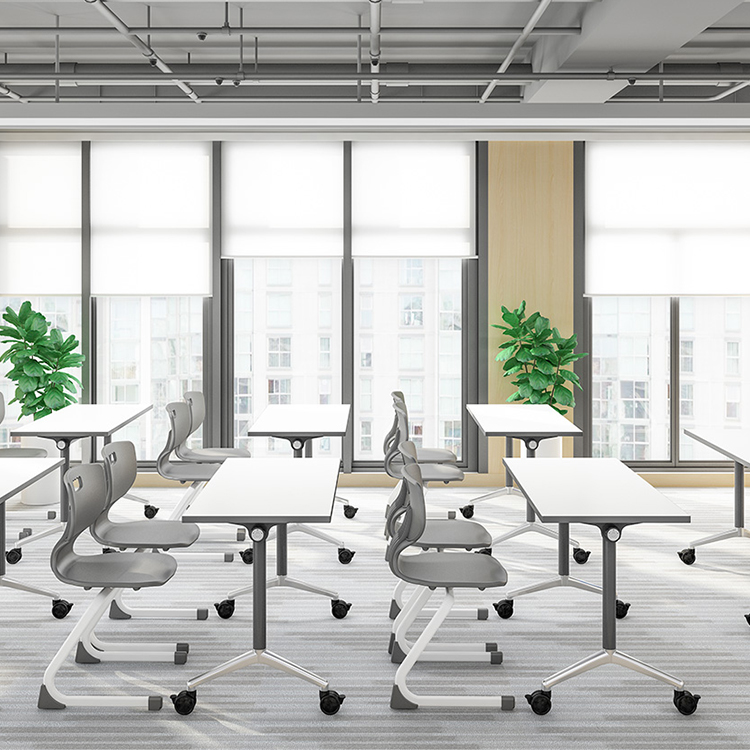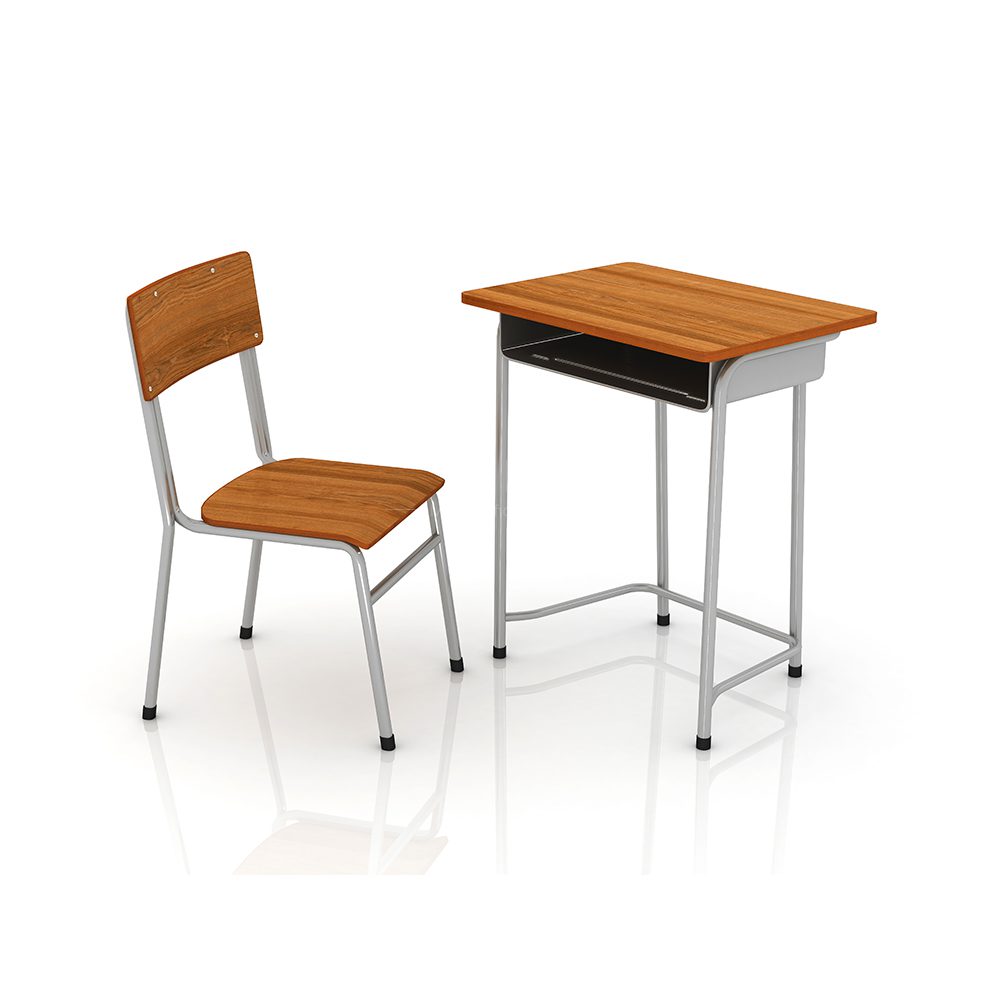Choosing the right student chair and desk set is more than just a matter of aesthetics; it’s a key investment in a student’s productivity and comfort. When we consider how many hours students spend seated while studying, it becomes clear that the quality of their furniture can significantly impact their learning experience and overall well-being. Ergonomically designed furniture not only supports healthy posture but also reduces physical strain, thereby enhancing focus and efficiency. In this blog, we will delve into the critical aspects of selecting the ideal student chair and desk set, covering everything from ergonomics to aesthetic considerations and providing you with a comprehensive guide to make an informed choice.
Understanding Ergonomics
Ergonomics is the science of designing environments and products to fit the people who use them rather than forcing users to conform to the environment or product. When it comes to student furniture, ergonomics is crucial for several reasons. Firstly, ergonomic furniture is designed to support the body’s natural posture, which helps prevent musculoskeletal disorders and reduces physical strain. A poorly designed chair or desk can lead to discomfort and long-term health issues, such as back pain, neck strain, and even repetitive strain injuries.
Ergonomic principles in student furniture revolve around providing adjustable features that cater to the unique body dimensions of each student. This includes adjustable seat height, backrest angle, and desk height. The goal is to maintain a neutral body posture where the feet are flat on the floor, the knees are at a right angle, and the back is well-supported by the chair’s backrest. This alignment reduces the pressure on the spine and encourages better circulation, which in turn can improve concentration and learning efficiency.
In addition to physical health, ergonomics also impacts cognitive performance. A comfortable and supportive seating arrangement reduces distractions caused by discomfort, allowing students to focus more on their studies. By investing in ergonomically designed student furniture, you are promoting a healthier and more effective learning environment.
By understanding and applying ergonomic principles, you can make informed decisions when selecting student furniture that will contribute significantly to a student’s academic success and overall well-being.
Key Features to Look For

School Training Table
When selecting the perfect student chair and desk set, various essential features must be taken into account to ensure both comfort and productivity. Here’s a detailed look at what to consider:
1. Adjustable Height:
- Why it matters: Adjustable height is crucial as it allows the furniture to grow with the student, accommodating different stages of their development.
Benefits: By adjusting the height, students can maintain a proper posture, reducing the risk of musculoskeletal issues.
2. Lumbar Support:
- Why it matters: Lumbar support helps in maintaining the natural curve of the spine, essential for long-term health.
- Benefits: Good lumbar support can prevent back pain and promote a healthier sitting posture.
3. Desktop Space:
- Why it matters: Sufficient desktop space is important for accommodating textbooks, laptops, and other study materials without clutter.
- Benefits: A spacious desktop allows for more organized and productive study sessions.
4. Material Durability:
- Why it matters: Durable materials ensure that the furniture can withstand daily wear and tear, making it a cost-effective investment.
- Benefits: High-quality materials contribute to the overall longevity of the furniture, reducing the need for frequent replacements.
Investing in furniture with these key features can significantly enhance a student’s comfort and productivity, laying the foundation for a successful learning experience.
Types of Student Chairs and Desks
There are several types of student chairs and desks available on the market, each with its own set of advantages and disadvantages. Here’s a comprehensive overview:
1. Traditional Desks and Chairs:
- Pros:
- Typically more affordable.
- Readily available in various styles and sizes.
- Sturdy and durable for long-term use.
- Cons:
- Limited adjustability.
- May not offer ergonomic support.
2. Standing Desks:
- Pros:
- Promote better posture and reduce the risk of sedentary lifestyle-related health issues.
- Can help improve focus and productivity.
- Adjustable options available for sitting and standing.
- Cons:
- Generally more expensive.
- May require additional accessories like anti-fatigue mats.
3. Combination Units:
- Pros:
- Offer flexibility with both sitting and standing options.
- Usually come with built-in storage solutions.
- Ideal for small spaces due to their multifunctional design.
- Cons:
- Can be more complex to adjust.
- Higher price point compared to traditional sets.
Choosing the right type of student chair and desk involves considering the specific needs and preferences of the student, as well as the available space and budget. Each type has its unique benefits, making it crucial to weigh the pros and cons before making a decision.
By understanding these key features and the types available, you can make an informed choice that will benefit the student’s learning environment and overall well-being.
Age and Size Considerations

School chair and desk
Choosing the right size and type of furniture for students of different ages and body sizes is critical to their comfort and productivity. Here are guidelines and tips to ensure you make an informed decision:
1. Age-Specific Recommendations:
- Kindergarten to Primary School (Ages 4-10): For younger children, consider desks and chairs that are lower in height. Adjustable furniture is ideal as it can grow with the child. Look for desks with rounded edges to prevent injuries.
- Middle School (Ages 11-13): At this stage, students need larger desks and chairs that support their growing bodies. Ensure that the furniture has adjustable features to accommodate height changes.
- High School to College (Ages 14-22): For older students, ergonomic furniture becomes increasingly important. Desks should provide ample workspace for books and computers, and chairs should offer strong lumbar support and adjustable features.
2. Measuring Tips:
- Desk Height: The desk should be at the level of the student’s elbows when they are seated, allowing their forearms to rest comfortably on the surface.
- Chair Height: The chair height should be such that the student’s feet rest flat on the floor and their knees are at a 90-degree angle.
- Backrest: The backrest should support the natural curve of the spine, particularly the lower back.
3. Growth-Friendly Features:
- Adjustable Desks and Chairs: These allow the furniture to be used for several years as the student grows.
- Reconfigurable Units: Some furniture sets can be reconfigured to suit different activities and needs as the student matures.
4. Space Considerations:
- Ensure that the furniture fits well within the study area without making it feel cramped. Measure the available space and compare it with the dimensions of the furniture before purchasing.
Budget and Quality

School Training Desk
Balancing your budget with the need for high-quality furniture can be challenging, but these tips will guide you toward making a wise investment:
1. Budget-Friendly Options:
- Material Choices: Opt for furniture made from durable yet affordable materials like engineered wood or high-quality plastic.
- Basic Ergonomics: Even budget options can include basic ergonomic features like lumbar support and adjustable height.
2. Quality Indicators:
- Durability: Look for furniture that uses robust materials such as metal frames and high-density padding for chairs. This ensures longevity and reduces the need for frequent replacements.
- Warranty: A good warranty indicates the manufacturer’s confidence in their product’s quality. Always check the warranty terms.
3. When to Invest More:
- Frequent Use: If the furniture will be used for many hours each day, it’s worth investing in higher-quality pieces that offer better ergonomic support and comfort.
- Health Concerns: Students with specific health needs, such as back issues, may benefit greatly from investing in premium ergonomic furniture.
4. Balancing Cost and Features:
- Feature Prioritization: Identify the most important features you need, such as adjustable height or lumbar support, and focus your budget on those.
- Sales and Discounts: Keep an eye out for seasonal sales, discounts, and bundle deals that can provide high-quality furniture at a lower cost.
By considering these factors, you can ensure that you are selecting student furniture that is both appropriately sized and within your budget without compromising on quality.
Aesthetic and Design

School Training Table
In the realm of student furniture, aesthetic appeal, and design play a pivotal role in creating an engaging and inspiring study environment. The right design can significantly influence a student’s mood, motivation, and productivity. Here are several key aspects to consider when choosing aesthetically pleasing furniture for students:
- Color Schemes: Opt for colors that are known to boost concentration and reduce stress. Soft blues and greens are calming, while yellows and oranges can invigorate and motivate.
- Modern Trends: Contemporary designs often lean towards minimalism with clean lines, which can help reduce visual clutter and promote focus. Look for furniture that incorporates these modern trends without compromising functionality.
- Personalization: Allowing students to personalize their study space can increase their sense of ownership and comfort. Choose furniture that can easily accommodate personal touches, such as magnetic boards or pin-up areas.
- Space Efficiency: Especially in smaller rooms, furniture that maximizes space is crucial. Multi-functional pieces, such as desks with built-in storage or chairs that can be easily stowed away, are excellent choices.
- Material and Finish: The choice of material and finish can also impact the aesthetic and feel of a study space. Natural wood finishes can add warmth, while metal and glass combinations can give a sleek, modern look.
By paying attention to these design elements, you can create a study environment that not only looks good but also supports the student’s academic endeavors and personal well-being.
Conclusion
Selecting the right student chair and desk set is more than just a purchase; it’s an investment in a student’s education and health. By understanding ergonomics, identifying key features, and considering age, size, and budget, you can make an informed choice that enhances productivity and comfort. Additionally, don’t overlook the importance of aesthetics and design, as these elements can greatly influence a student’s motivation and enjoyment of their study space.
Ready to transform your student’s study environment? Explore our range of ergonomic and stylish student furniture today at Meet&Co Office Furniture. Join us in creating healthy, happy, and productive learning spaces!



